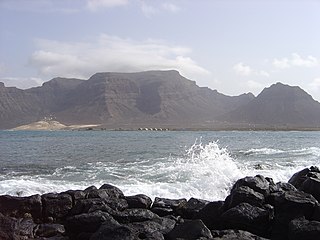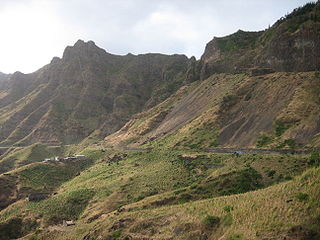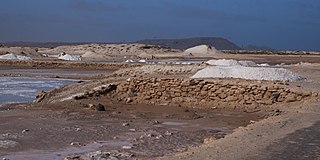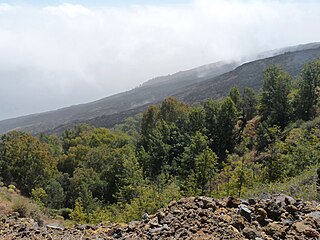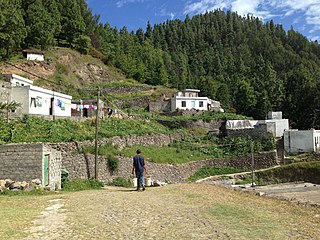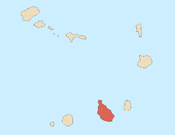| Monte das Vacas | |
|---|---|
northern Santiago | |
| Highest point | |
| Elevation | 437 m (1,434 ft) |
| Listing | List of mountains in Cape Verde |
| Coordinates | 14°59′32″N23°32′20″W / 14.9923°N 23.5390°W Coordinates: 14°59′32″N23°32′20″W / 14.9923°N 23.5390°W |
| Geography | |
| Location | northern Santiago |
| Geology | |
| Age of rock | Miocene and Pliocene |
| Mountain type | Stratovolcano |
| Type of rock | basalt, basanite |
| Climbing | |
| Easiest route | climb |
Monte das Vacas is a mountain located in the southeastern part of the island of Santiago, Cape Verde 8 km from the capital Praia, north of the subdivision of Achada de São Filipe and southwest of Ribeirão Chiqueiro. Its elevation is 437 meters. From its base it is around 150 meters from the plateau at an elevation of 180 meters.

A mountain is a large landform that rises above the surrounding land in a limited area, usually in the form of a peak. A mountain is generally steeper than a hill. Mountains are formed through tectonic forces or volcanism. These forces can locally raise the surface of the earth. Mountains erode slowly through the action of rivers, weather conditions, and glaciers. A few mountains are isolated summits, but most occur in huge mountain ranges.

Santiago is the largest island of Cape Verde, its most important agricultural centre and home to half the nation’s population. Part of the Sotavento Islands, it lies between the islands of Maio and Fogo. It was the first of the islands to be settled: the town of Ribeira Grande was founded in 1462. Santiago is home to the nation's capital city of Praia.

Cape Verde or Cabo Verde, officially the Republic of Cabo Verde, is an island country spanning an archipelago of 10 volcanic islands in the central Atlantic Ocean. It forms part of the Macaronesia ecoregion, along with the Azores, Canary Islands, Madeira, and the Savage Isles. In ancient times these islands were referred to as "the Islands of the Blessed" or the "Fortunate Isles". Located 570 kilometres (350 mi) west of the Cape Verde Peninsula off the coast of Northwest Africa, the islands cover a combined area of slightly over 4,000 square kilometres (1,500 sq mi).
Contents
The mountain is of volcanic origin and is made up of what was a large volcanic crater, once a subsidiary vent, it was not often erupted as in Pico da Antónia millions of years ago. Only the southwest part remains along with bits of the northeast while the remainder are eroded.
Most of the mountain is in the Praia, the northernmost part is in São Domingos with the boundaries going east-west at the mid north part. Less than a kilometer north is the 15th parallel north. East is the Praia-Tarrafal Route, the EN1-ST01 (Primary Route 1) and west is Ribeira da Veneza with its settlement in the southwest. South is the source of Ribeira de São Filipe, a small stream that empties into Ribeira da Trindade just short of Praia Harbour.
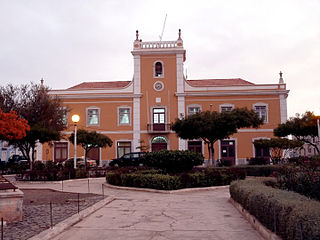
Praia is a concelho (municipality) of Cape Verde. It is situated in the southern part of the island of Santiago. Its seat is the city Praia, the capital of Cape Verde. Its area is 120.6 km2 (46.6 sq mi), and its population was 131,719 at the 2010 census. The municipality consists of one freguesia, Nossa Senhora da Graça. The city hall is located in the Platô part of the city.

São Domingos is a concelho (municipality) of Cape Verde. It is situated in the southeastern part of the island of Santiago. Its seat is the city São Domingos. Its population was 13,699 at the 2010 census, and its area is 147.5 km2.

The 15th parallel north is a circle of latitude that is 15 degrees north of the Earth's equatorial plane. It crosses Africa, Asia, the Indian Ocean, the Pacific Ocean, Central America, the Caribbean and the Atlantic Ocean.
Surrounding the mountains, the outer areas are forested but the middle portion are grassland. Before settlements appeared at the 15th century, it was believed to be dominated by shrubs, decades later, it became mostly a barren grassland.
Its geology consists of the Monte das Vacas formation spreading across the southeast portion of the island and including much of its hills, it was formed between 1 million to 700,000 years ago. [1]
During the Ice Age, its elevation was about 567 meters, at around 10000 BC, the elevation was at 500 meters, up to about 4000 BC, the elevation was at 450 meters.



